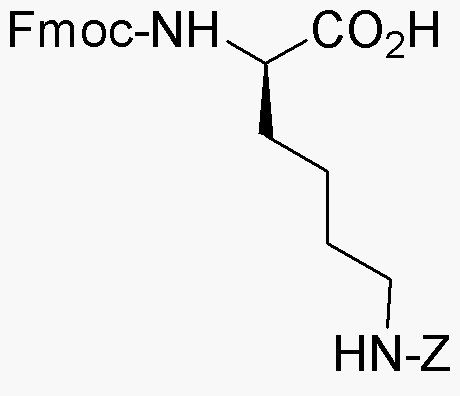Na-Fmoc-Ne-Z-D-lysine is widely utilized in research focused on:
- Peptide Synthesis: This compound serves as a key building block in the synthesis of peptides, allowing researchers to create complex structures for various applications in drug development.
- Bioconjugation: Its unique protective group facilitates the conjugation of peptides to other molecules, enhancing the delivery and efficacy of therapeutic agents in pharmaceutical applications.
- Protein Engineering: Used in the modification of proteins, it helps in studying protein interactions and functions, which is crucial for understanding biological processes.
- Drug Design: The compound's structure allows for the design of novel drugs that can target specific biological pathways, providing an advantage in developing more effective treatments.
- Research in Cancer Therapy: It is employed in the development of targeted therapies, where its ability to modify peptides can lead to more precise treatments with fewer side effects.
Información general
Propiedades
Seguridad y normativas
Aplicaciones
Na-Fmoc-Ne-Z-D-lysine is widely utilized in research focused on:
- Peptide Synthesis: This compound serves as a key building block in the synthesis of peptides, allowing researchers to create complex structures for various applications in drug development.
- Bioconjugation: Its unique protective group facilitates the conjugation of peptides to other molecules, enhancing the delivery and efficacy of therapeutic agents in pharmaceutical applications.
- Protein Engineering: Used in the modification of proteins, it helps in studying protein interactions and functions, which is crucial for understanding biological processes.
- Drug Design: The compound's structure allows for the design of novel drugs that can target specific biological pathways, providing an advantage in developing more effective treatments.
- Research in Cancer Therapy: It is employed in the development of targeted therapies, where its ability to modify peptides can lead to more precise treatments with fewer side effects.
Documentos
Hojas de datos de seguridad (HDS)
La SDS proporciona información de seguridad completa sobre la manipulación, el almacenamiento y la eliminación del producto.
Especificación del producto (PS)
La PS proporciona un desglose completo de las propiedades del producto, incluida la composición química, el estado físico, la pureza y los requisitos de almacenamiento. También detalla los rangos de calidad aceptables y las aplicaciones previstas del producto.
Certificados de análisis (COA)
Busque certificados de análisis (COA) ingresando el número de lote del producto. Los números de lote y de partida se pueden encontrar en la etiqueta de un producto después de las palabras "Lote" o "Lote".
Número de catálogo
Número de lote/lote
Certificados de origen (COO)
Este certificado de origen confirma el país en el que se fabricó el producto y también detalla los materiales y componentes utilizados en él y si se deriva de fuentes naturales, sintéticas u otras fuentes específicas. Este certificado puede ser necesario para cumplir con las normativas aduaneras, comerciales y regulatorias.
Número de catálogo
Número de lote/lote
Hojas de datos de seguridad (HDS)
La SDS proporciona información de seguridad completa sobre la manipulación, el almacenamiento y la eliminación del producto.
DownloadEspecificación del producto (PS)
La PS proporciona un desglose completo de las propiedades del producto, incluida la composición química, el estado físico, la pureza y los requisitos de almacenamiento. También detalla los rangos de calidad aceptables y las aplicaciones previstas del producto.
DownloadCertificados de análisis (COA)
Busque certificados de análisis (COA) ingresando el número de lote del producto. Los números de lote y de partida se pueden encontrar en la etiqueta de un producto después de las palabras "Lote" o "Lote".
Número de catálogo
Número de lote/lote
Certificados de origen (COO)
Este certificado de origen confirma el país en el que se fabricó el producto y también detalla los materiales y componentes utilizados en él y si se deriva de fuentes naturales, sintéticas u otras fuentes específicas. Este certificado puede ser necesario para cumplir con las normativas aduaneras, comerciales y regulatorias.


